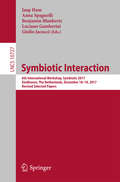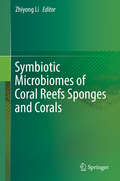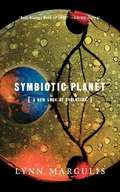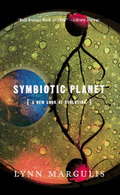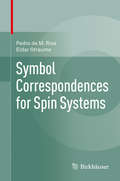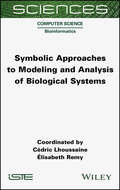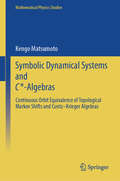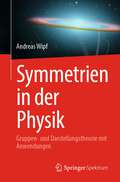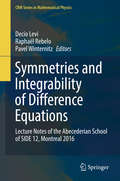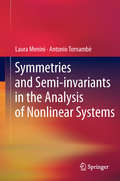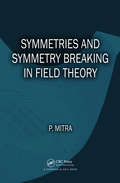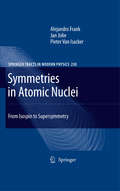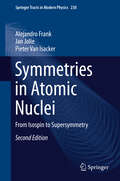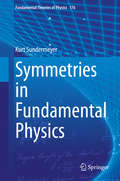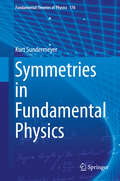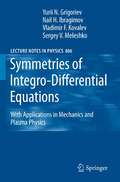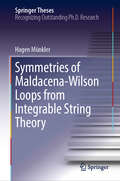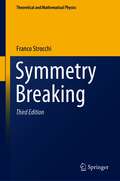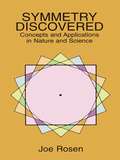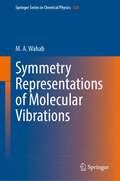- Table View
- List View
Symbiotic Interaction: 4th International Workshop, Symbiotic 2015, Berlin, Germany, October 7-8, 2015, Proceedings (Theoretical Computer Science and General Issues #9359)
by Giulio Jacucci Luciano Gamberini Anna Spagnolli Benjamin Blankertz Jaap HamThis book constitutes the proceedings of the 6th International Workshop on Symbiotic Interaction, Symbiotic 2017, held in Eindhoven, The Netherlands in December 2017. The 8 full papers, 2 short papers and 1 report presented in this volume were carefully reviewed and selected from 23 submissions. The International Workshop on Symbiotic Interaction is the primary venue for presenting scientific work dealing with the symbiotic relationships between humans and computers and for discussing the nature and implications of such relationships.
Symbiotic Microbiomes of Coral Reefs Sponges and Corals
by Zhiyong LiThis book focuses on the symbiotic microbiomes of invertebrates in coral reefs, especially sponges and corals. It provides in-depth and up-to-date reviews on the microbial structure and diversity, metabolism and function, symbiosis and coevolution, environment and adaption, and bioactive potentials. Meanwhile, the future perspectives will be discussed according to the existing problems and the development trend. This book will be of particular interest to the professionals in marine ecology, marine biotechnology, as well as medicinal chemists and molecular biologists.
Symbiotic Planet: A New Look At Evolution
by Lynn MargulisAuthor shows that symbiosis, which simply means members of different species living in physical contact with one another, is crucial to the origins of evolutionary novelty.
Symbiotic Planet: A New Look At Evolution
by Lynn MargulisNamed OCObest biology book of the yearOCO by Library Journal, "Symbiotic Planet" describes how symbiosis is the key to understanding the origins of cells, the evolution of sex, the emergence of life on land, and even the physiology of our planet. "
Symbiotic Soil Microorganisms: Biology and Applications (Soil Biology #60)
by Ajit Varma Neeraj Shrivastava Shubhangi MahajanThis book explores microbial symbiosis, with a particular focus on soil microorganisms, highlighting their application in enhancing plant growth and yield. It addresses various types of bacterial and fungal microbes associated with symbiotic phenomena, including rhizobium symbiosis, arbuscular mycorrhizal symbiosis, ectomycorrhizal symbiosis, algal/lichen symbiosis, and Archeal symbiosis.Presenting strategies for employing a diverse range of bacterial and fungal symbioses in nutrient fortification, adaptation of plants in contaminated soils, and mitigating pathogenesis, it investigates ways of integrating diverse approaches to increase crop production under the current conventional agroecosystem.Providing insights into microbial symbioses and the challenges of adopting a plant-microbe synergistic approach towards plant health, this book is a valuable resource for researchers, graduate students and anyone in industry working on bio-fertilizers and their agricultural applications.
Symbol Correspondences for Spin Systems
by Pedro de M. Rios Eldar StraumeIn mathematical physics, the correspondence between quantum and classical mechanics is a central topic, which this book explores in more detail in the particular context of spin systems, that is, SU(2)-symmetric mechanical systems. A detailed presentation of quantum spin-j systems, with emphasis on the SO(3)-invariant decomposition of their operator algebras, is first followed by an introduction to the Poisson algebra of the classical spin system and then by a similarly detailed examination of its SO(3)-invariant decomposition. The book next proceeds with a detailed and systematic study of general quantum-classical symbol correspondences for spin-j systems and their induced twisted products of functions on the 2-sphere. This original systematic presentation culminates with the study of twisted products in the asymptotic limit of high spin numbers. In the context of spin systems it shows how classical mechanics may or may not emerge as an asymptotic limit of quantum mechanics. The book will be a valuable guide for researchers in this field and its self-contained approach also makes it a helpful resource for graduate students in mathematics and physics.
Symbolic Approaches to Modeling and Analysis of Biological Systems
by Cédric Lhoussaine Élisabeth RemySystems Biology is an approach to biology that involves understanding the complexity of interactions among biological entities within a systemic whole. The goal is to understand the emergence of physiological or functional properties. Symbolic Approaches to Modeling and Analysis of Biological Systems presents contributions of formal methods from computer science for modeling the dynamics of biological systems. It deals more specifically with symbolic methods, i.e. methods that can establish the qualitative properties of models. This book presents different approaches related to semantics, language, modeling and their link with data, and allows us to examine the fundamental problems and challenges that biological systems are facing. The first part of the book presents works that rely on various available data to build models, while the second part gathers contributions surrounding issues of semantics and formal methods.
Symbolic Dynamical Systems and C*-Algebras: Continuous Orbit Equivalence of Topological Markov Shifts and Cuntz–Krieger Algebras (Mathematical Physics Studies)
by Kengo MatsumotoThis book presents the interplay between topological Markov shifts and Cuntz–Krieger algebras by providing notations, techniques, and ideas in detail. The main goal of this book is to provide a detailed proof of a classification theorem for continuous orbit equivalence of one-sided topological Markov shifts. The continuous orbit equivalence of one-sided topological Markov shifts is classified in terms of several different mathematical objects: the étale groupoids, the actions of the continuous full groups on the Markov shifts, the algebraic type of continuous full groups, the Cuntz–Krieger algebras, and the K-theory dates of the Cuntz–Krieger algebras. This classification result shows that topological Markov shifts have deep connections with not only operator algebras but also groupoid theory, infinite non-amenable groups, group actions, graph theory, linear algebras, K-theory, and so on. By using this classification result, the complete classification of flow equivalence in two-sided topological Markov shifts is described in terms of Cuntz–Krieger algebras. The author will also study the relationship between the topological conjugacy of topological Markov shifts and the gauge actions of Cuntz–Krieger algebras.
Symbolic Mathematics for Chemists: A Guide for Maxima Users
by Fred SeneseAn essential guide to using Maxima, a popular open source symbolic mathematics engine to solve problems, build models, analyze data and explore fundamental concepts Symbolic Mathematics for Chemists offers students of chemistry a guide to Maxima, a popular open source symbolic mathematics engine that can be used to solve problems, build models, analyze data, and explore fundamental chemistry concepts. The author — a noted expert in the field — focuses on the analysis of experimental data obtained in a laboratory setting and the fitting of data and modeling experiments. The text contains a wide variety of illustrative examples and applications in physical chemistry, quantitative analysis and instrumental techniques. Designed as a practical resource, the book is organized around a series of worksheets that are provided in a companion website. Each worksheet has clearly defined goals and learning objectives and a detailed abstract that provides motivation and context for the material. This important resource: Offers an text that shows how to use popular symbolic mathematics engines to solve problems Includes a series of worksheet that are prepared in Maxima Contains step-by-step instructions written in clear terms and includes illustrative examples to enhance critical thinking, creative problem solving and the ability to connect concepts in chemistry Offers hints and case studies that help to master the basics while proficient users are offered more advanced avenues for exploration Written for advanced undergraduate and graduate students in chemistry and instructors looking to enhance their lecture or lab course with symbolic mathematics materials, Symbolic Mathematics for Chemists: A Guide for Maxima Users is an essential resource for solving and exploring quantitative problems in chemistry.
Symmetrien in der Physik: Gruppen- und Darstellungstheorie mit Anwendungen
by Andreas WipfDas vorliegende Buch führt durch die Symmetrien in der Physik: Es werden wichtige Gruppen und Symmetrien aus der Molekülphysik, der Festkörperphysik und (Quanten-)Feldtheorie vorgestellt und behandelt. Das Buch richtet sich an Studierende der Physik, die entweder die Vorlesung zur Gruppen- und Darstellungstheorie hören oder sich im Rahmen einer Bachelor-, Master- oder Doktorarbeit in Gruppentheorie und Symmetrien in der Physik einlesen möchten. Behandelt werden u.a. endliche und kontinuierliche Gruppen sowie Lie-Algebren und deren Darstellungen, aber auch klassische und quantisierte Feldtheorien, Eichtheorien und konforme Feldtheorien. Der Autor verbindet in den Kapiteln die mathematischen Grundlagen mit der physikalischen Anwendung. Beispiele, Aufgaben und Zwischenfragen helfen Leserinnen und Lesern dabei, ihr Verständnis zu überprüfen..
Symmetries and Dynamics of Star Clusters
by Jaroslav HaasIn this PhD thesis, which was nominated for publication in this series by the Astronomical Institute at Charles University, Prague, the author investigates the orbital evolution of an initially thin stellar disc around a supermassive black hole, considering various perturbative sources of gravity. His findings, obtained by both direct numerical N-body modelling and using standard perturbation methods, offer a viable theoretical explanation for the observed configuration of young stars in the Galactic Centre. This marks a significant contribution to a topic of great interest in contemporary astrophysics. The author also shows in his thesis that a secular instability (m = 1 mode) may occur in the embedding spherical cluster of old stars. This increases the richness of possible evolution scenarios of the embedding cluster and may lead to effective feeding of supermassive black holes through tidal disruption of stars on extremely eccentric orbits.
Symmetries and Integrability of Difference Equations
by Decio Levi Raphaël Rebelo Pavel WinternitzDifference equations are playing an increasingly important role in the natural sciences. Indeed many phenomena are inherently discrete and are naturally described by difference equations. Phenomena described by differential equations are therefore approximations of more basic discrete ones. Moreover, in their study it is very often necessary to resort to numerical methods. This always involves a discretization of the differential equations involved, thus replacing them by difference equations. This book shows how Lie group and integrability techniques, originally developed for differential equations, have been adapted to the case of difference ones. Each of the eleven chapters is a self-contained treatment of a topic, containing introductory material as well as the latest research results. The book will be welcomed by graduate students and researchers seeking an introduction to the field. As a survey of the current state of the art it will also serve as a valuable reference.
Symmetries and Semi-invariants in the Analysis of Nonlinear Systems
by Antonio Tornambè Laura MeniniThis book details the analysis of continuous- and discrete-time dynamical systems described by differential and difference equations respectively. Differential geometry provides the tools for this, such as first-integrals or orbital symmetries, together with normal forms of vector fields and of maps. A crucial point of the analysis is linearization by state immersion. The theory is developed for general nonlinear systems and specialized for the class of Hamiltonian systems. By using the strong geometric structure of Hamiltonian systems, the results proposed are stated in a different, less complex and more easily comprehensible manner. They are applied to physically motivated systems, to demonstrate how much insight into known properties is gained using these techniques. Various control systems applications of the techniques are characterized including: computation of the flow of nonlinear systems; computation of semi-invariants; computation of Lyapunov functions for stability analysis and observer design.
Symmetries and Symmetry Breaking in Field Theory
by Parthasarathi MitraMany courses on modern quantum field theory focus on the formulation and application of field theory, leaving topics related to symmetry underdeveloped. This leads to students often having an incomplete understanding of symmetries. Filling this gap, Symmetries and Symmetry Breaking in Field Theory sheds light on various aspects of symmetry in field
Symmetries in Atomic Nuclei
by Pieter Van Isacker Jan Jolie Alejandro FrankSymmetries in Atomic Nuclei aims to present an overview of recent applications of symmetry to the description of atomic nuclei. Special care is given to a pedagogical introduction of symmetry concepts using simple examples. After a historical overview of the applications of symmetry in nuclear physics, progress in the field during the last decade is reviewed. Special emphasis is put on the introduction of neutron-proton and boson-fermion degrees of freedom. Their combination leads to a supersymmetric description of pairs and quartets of nuclei. Both theoretical aspects and experimental signatures of dynamical (super)symmetries are carefully discussed. Case studies show how these symmetries are displayed by real atomic nuclei which have been studied experimentally using state-of-the art spectroscopy. This book focuses on nuclear structure physics and has been written by active investigators in the field, but its scope is wider and is intended for final-year or post-graduate students and researchers interested in understanding the power and beauty of symmetry methods in physics.
Symmetries in Atomic Nuclei: From Isospin to Supersymmetry (Springer Tracts in Modern Physics #230)
by Jan Jolie Alejandro Frank Pieter Van IsackerThe revised edition of this established work presents an extended overview of recent applications of symmetry to the description of atomic nuclei, including a pedagogical introduction to symmetry concepts using simple examples. Following a historical overview of the applications of symmetry in nuclear physics, attention turns to more recent progress in the field. Special emphasis is placed on the introduction of neutron-proton and boson-fermion degrees of freedom. Their combination leads to a supersymmetric description of pairs and quartets of nuclei. Expanded and updated throughout, the book now features separate chapters on the nuclear shell model and the interacting boson model, the former including discussion of recent results on seniority in a single-j shell. Both theoretical aspects and experimental signatures of dynamical (super)symmetries are carefully discussed. This book focuses on nuclear structure physics, but its broad scope makes it suitable for final-year or post-graduate students and researchers interested in understanding the power and beauty of symmetry methods in physics.Review of the 1st Edition:"The subject of this book, symmetries in physical systems, with particular focus on atomic nuclei, is of the utmost importance in modern physical science. In contrast to most treatments, frequently characterized by fearsome formalism, this book leads the reader step-by-step, in an easily understandable way, through this fascinating field...this book is remarkably accessible to both theorists and experimentalists. Indeed, I view it as essential reading for experimental nuclear structure physicists. This is one of the finest volumes on this subject I have ever encountered." Prof. R.F. Casten, Yale University
Symmetries in Fundamental Physics
by Kurt SundermeyerOver the course of the last century it has become clear that both elementary particle physics and relativity theories are based on the notion of symmetries. These symmetries become manifest in that the "laws of nature" are invariant under spacetime transformations and/or gauge transformations. The consequences of these symmetries were analyzed as early as in 1918 by Emmy Noether on the level of action functionals. Her work did not receive due recognition for nearly half a century, but can today be understood as a recurring theme in classical mechanics, electrodynamics and special relativity, Yang-Mills type quantum field theories, and in general relativity. As a matter of fact, as shown in this monograph, many aspects of physics can be derived solely from symmetry considerations. This substantiates the statement of E. P. Wigner ". . . if we knew all the laws of nature, or the ultimate Law of nature, the invariance properties of these laws would not furnish us new information. " Thanks to Wigner we now also understand the implications of quantum physics and symmetry considerations: Poincare invariance dictates both the characteristic properties of particles (mass, spin, . . . ) and the wave equations of spin 0, 1/2, 1, . . . objects. Further, the work of C. N. Yang and R. Mills reveals the consequences of internal symmetries as exemplified in the symmetry group of elementary particle physics. Given this pivotal role of symmetries it is thus not surprising that current research in fundamental physics is to a great degree motivated and inspired by considerations of symmetry. The treatment of symmetries in this monograph ranges from classical physics to now well-established theories of fundamental interactions, to the latest research on unified theories and quantum gravity.
Symmetries in Fundamental Physics (Fundamental Theories of Physics #176)
by Kurt SundermeyerOver the course of the last century it has become clear that both elementary particle physics and relativity theories are based on the notion of symmetries. These symmetries become manifest in that the "laws of nature" are invariant under spacetime transformations and/or gauge transformations. The consequences of these symmetries were analyzed as early as in 1918 by Emmy Noether on the level of action functionals. Her work did not receive due recognition for nearly half a century, but can today be understood as a recurring theme in classical mechanics, electrodynamics and special relativity, Yang-Mills type quantum field theories, and in general relativity. As a matter of fact, as shown in this monograph, many aspects of physics can be derived solely from symmetry considerations. This substantiates the statement of E.P.Wigner "... if we knew all the laws of nature, or the ultimate Law of nature, the invariance properties of these laws would not furnish us new information." Thanks to Wigner we now also understand the implications of quantum physics and symmetry considerations: Poincare invariance dictates both the characteristic properties of particles (mass, spin, ...) and the wave equations of spin 0, 1/2, 1, ... objects. Further, the work of C.N.Yang and R.Mills reveals the consequences of internal symmetries as exemplified in the symmetry group of elementary particle physics. Given this pivotal role of symmetries it is thus not surprising that current research in fundamental physics is to a great degree motivated and inspired by considerations of symmetry.The treatment of symmetries in this monograph ranges from classical physics to now well-established theories of fundamental interactions, to the latest research on unified theories and quantum gravity.
Symmetries in Quantum Mechanics: From Angular Momentum to Supersymmetry (PBK)
by M Chaichian R HagedornSymmetries in Quantum Mechanics: From Angular Momentum to Supersymmetry (PBK) provides a thorough, didactic exposition of the role of symmetry, particularly rotational symmetry, in quantum mechanics. The bulk of the book covers the description of rotations (geometrically and group-theoretically) and their representations, and the quantum theory of angular momentum. Later chapters introduce more advanced topics such as relativistic theory, supersymmetry, anyons, fractional spin, and statistics. With clear, in-depth explanations, the book is ideal for use as a course text for postgraduate and advanced undergraduate students in physics and those specializing in theoretical physics. It is also useful for researchers looking for an accessible introduction to this important area of quantum theory.
Symmetries of Integro-Differential Equations: With Applications in Mechanics and Plasma Physics
by N. Kh. Ibragimov Sergey V. Meleshko Yurii N. Grigoriev Vladimir F. KovalevThis book aims to coherently present applications of group analysis to integro-differential equations in an accessible way. The book will be useful to both physicists and mathematicians interested in general methods to investigate nonlinear problems using symmetries. Differential and integro-differential equations, especially nonlinear, present the most effective way for describing complex processes. Therefore, methods to obtain exact solutions of differential equations play an important role in physics, applied mathematics and mechanics. This book provides an easy to follow, but comprehensive, description of the application of group analysis to integro-differential equations. The book is primarily designed to present both fundamental theoretical and algorithmic aspects of these methods. It introduces new applications and extensions of the group analysis method. The authors have designed a flexible text for postgraduate courses spanning a variety of topics.
Symmetries of Maldacena-Wilson Loops from Integrable String Theory (Springer Theses)
by Hagen MünklerThe book discusses hidden symmetries in the Anti-de Sitter/conformal field theory (AdS/CFT) duality. This duality is a modern concept that asserts an exact duality between conformally invariant quantum field theories and string theories in higher dimensional Anti-de Sitter spaces, and in this way provides a completely new tool for the study of strongly coupled quantum field theories. In this setting, the book focuses on the Wilson loop, an important observable in four-dimensional maximally supersymmetric gauge theory. The dual string description using minimal surfaces enables a systematic study of the hidden symmetries of the loop. The book presents major findings, including the discovery of a master symmetry for strings in general symmetric spaces, its relation to the Yangian symmetry algebra and its action on the minimal surfaces appearing in the dual string description of the Wilson loop. Moreover, it clarifies why certain symmetries are not present on the gauge theory side for purely bosonic Wilson loops and, lastly, how the supersymmetrization of the minimal surface problem for type IIB superstrings can be undertaken. As such, it substantially increases our understanding and use of infinite dimensional symmetries occurring in the AdS/CFT correspondence.
Symmetries, Integrable Systems and Representations
by Sophie Morier-Genoud Kenji Iohara Bertrand RémyThis volume is the result of two international workshops; Infinite Analysis 11 - Frontier of Integrability - held at University of Tokyo, Japan in July 25th to 29th, 2011, and Symmetries, Integrable Systems and Representations held at Université Claude Bernard Lyon 1, France in December 13th to 16th, 2011. Included are research articles based on the talks presented at the workshops, latest results obtained thereafter, and some review articles. The subjects discussed range across diverse areas such as algebraic geometry, combinatorics, differential equations, integrable systems, representation theory, solvable lattice models and special functions. Through these topics, the reader will find some recent developments in the field of mathematical physics and their interactions with several other domains.
Symmetry Breaking: A Non-perturbative Outlook (Theoretical and Mathematical Physics #732)
by Franco StrocchiThe third edition of the by now classic reference on rigorous analysis of symmetry breaking in both classical and quantum field theories adds new topics of relevance, in particular the effect of dynamical Coulomb delocalization, by which boundary conditions give rise to volume effects and to energy/mass gap in the Goldstone spectrum (plasmon spectrum, Anderson superconductivity, Higgs phenomenon). The book closes with a discussion of the physical meaning of global and local gauge symmetries and their breaking, with attention to the effect of gauge group topology in QCD. From the reviews of the first edition: It is remarkable to see how much material can actually be presented in a rigorous way (incidentally, many of the results presented are due to Strocchi himself), yet this is largely ignored, the original heuristic derivations being, as a rule, more popular. - At each step he strongly emphasizes the physical meaning and motivation of the various notions introduced [...] a book that fills a conspicuous gap in the literature, and does it rather well. It could also be a good basis for a graduate course in mathematical physics. J.-P. Antoine, Physicalia 28/2, 2006 Despite many accounts in popular textbooks and a widespread belief, the phenomenon is rather subtle, requires an infinite set of degrees of freedom and an advanced mathematical setting of the system under investigation. [...] The mathematically oriented graduate student will certainly benefit from this thorough, rigorous and detailed investigation. G. Roepstorff, Zentralblatt MATH, Vol. 1075, 2006 From the reviews of the second edition: This second edition of Strocchi’s Symmetry Breaking presents a complete, generalized and highly rigorous discussion of the subject, based on a formal analysis of conditions necessary for the mechanism of spontaneous symmetry breaking to occur in classical systems, as well as in quantum systems. […] This book is specifically recommended for mathematical physicists interested in a deeper and rigorous understanding of the subject, and it should be mandatory for researchers studying the mechanism of spontaneous symmetry breaking. S. Hajjawi, Mathematical Reviews, 2008
Symmetry Discovered: Concepts and Applications in Nature and Science
by Joe RosenSymmetry provides an insight into the way nature works and is often used by scientists and technologists to help solve problems. Symmetry has numerous other applications as well -- with more being discovered all the time in science, the arts and other fields of human endeavor.This classic work provides an excellent introduction to the basic concepts and terminology (including, optionally, group theory), as well as lucid discussions of geometric symmetry, other symmetries and appropriate symmetry, symmetry in nature, uses of symmetry in science and much more.Readers wishing to pursue specific topics will find many references that reflect the author's wide reading in the subject and his own obvious enthusiasm. For this edition, Dr. Rosen has provided a new preface, solutions to the problems, and an addendum to the bibliography.
Symmetry Representations of Molecular Vibrations (Springer Series in Chemical Physics #126)
by M.A. WahabThis book presents a comprehensive theoretical basis of symmetry representations of molecular vibrations, matrix representation of symmetries, and the elements of group theory that are relevant to other symmetry elements/operations, crystallographic and molecular point groups. The book helps understand the reducible and irreducible representations of symmetry matrices and then derive the normal modes of vibration of different molecules by using suitable techniques independently. Targeted to graduate students and researchers, this book aims not only to derive the normal modes of vibration of any given molecule themselves but also compares and verifies them with the experimentally found modes by using IR and Raman-related techniques. For the first time in the crystallographic history, this book presents the group multiplication tables of all 32 point groups in both international and Schoenflies notations.
